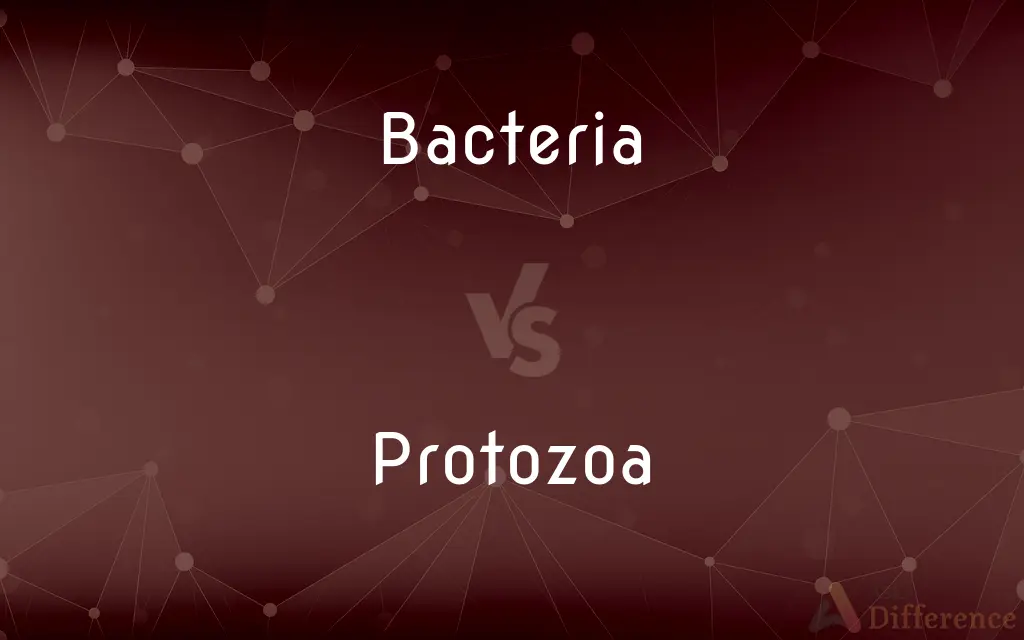Bacteria vs. Protozoa — What's the Difference?
By Maham Liaqat & Urooj Arif — Updated on March 13, 2024
Bacteria are single-celled, prokaryotic organisms with a simple cell structure, while protozoa are single-celled, eukaryotic organisms with a complex cell structure, including a nucleus.

Difference Between Bacteria and Protozoa
Table of Contents
ADVERTISEMENT
Key Differences
Bacteria are microscopic, single-celled organisms that belong to the domain Prokaryota, characterized by their simple cellular organization without a nucleus. They play various roles in the environment, human health, and industry, ranging from decomposition and nitrogen fixation to causing diseases. On the other hand, protozoa are a diverse group of single-celled eukaryotes, which means they have a more complex cellular structure that includes a nucleus and other organelles. Protozoa are primarily known for their role in disease causation and as essential parts of aquatic and terrestrial food chains.
The cell structure of bacteria is simpler; they lack membrane-bound organelles, such as mitochondria and chloroplasts, and their genetic material is not enclosed in a nuclear envelope. In contrast, protozoa have a well-defined nucleus containing their genetic material and possess various organelles that allow them to perform more complex functions, such as energy production and waste disposal.
Bacteria reproduce asexually through binary fission, a straightforward process where a single cell divides into two identical daughter cells. Protozoa, while also capable of asexual reproduction (typically through binary fission or budding), can engage in sexual reproduction as well, which introduces genetic variation into their populations.
Bacteria are omnipresent and are crucial for nutrient cycling, acting as decomposers and symbionts in various environments. Protozoa, with their ability to consume bacteria and other small particles, play a key role as predators in many ecosystems, controlling bacterial populations and serving as food for larger organisms.
Despite their differences, both bacteria and protozoa are essential to the biosphere, contributing to the complexity of ecosystems. Their interactions with humans and other life forms highlight the diversity of life at the microscopic level and the interconnectedness of biological processes.
ADVERTISEMENT
Comparison Chart
Kingdom
Prokaryota
Eukaryota
Cell Type
Prokaryotic (no nucleus, simple structure)
Eukaryotic (has nucleus, complex structure)
Reproduction
Primarily asexual (binary fission)
Asexual and sexual (binary fission, budding, etc.)
Cellular Organization
Lack membrane-bound organelles
Have membrane-bound organelles (e.g., nucleus)
Role in Environment
Decomposers, nitrogen fixers, pathogenic
Predators, disease causation, part of food chain
Compare with Definitions
Bacteria
Found in various environments, from soil to human bodies.
Soil bacteria play a crucial role in nitrogen fixation.
Protozoa
Single-celled, eukaryotic organisms with a nucleus.
Amoebas, a type of protozoa, are found in fresh water and soil.
Bacteria
Microscopic, single-celled organisms without a nucleus.
The gut flora consists mainly of beneficial bacteria aiding digestion.
Protozoa
Possess various organelles for complex functions.
Protozoa use their cilia or flagella for movement and feeding.
Bacteria
Can be beneficial or pathogenic to humans.
Some bacteria cause infections, while others are used in antibiotics production.
Protozoa
Can be free-living or parasitic.
Malaria is caused by the parasitic protozoa Plasmodium.
Bacteria
Reproduce through binary fission.
Bacteria populations can double rapidly due to their simple reproduction method.
Protozoa
Play a role as predators in many ecosystems.
Protozoa in water bodies feed on bacteria and help control their population.
Bacteria
Essential for nutrient cycling and decomposition.
Decomposing bacteria help recycle nutrients back into the ecosystem.
Protozoa
Capable of both asexual and sexual reproduction.
Some protozoa switch between reproductive modes depending on the environment.
Bacteria
Bacteria ( (listen); common noun bacteria, singular bacterium) are a type of biological cell. They constitute a large domain of prokaryotic microorganisms.
Protozoa
Protozoa (also protozoan, plural protozoans) is an informal term for a group of single-celled eukaryotes, either free-living or parasitic, that feed on organic matter such as other microorganisms or organic tissues and debris. Historically, protozoans were regarded as "one-celled animals", because they often possess animal-like behaviours, such as motility and predation, and lack a cell wall, as found in plants and many algae.
Bacteria
Plural of bacterium.
Protozoa
Any of numerous chiefly single-celled eukaryotic organisms, most of which move about freely and ingest food, including the amoebas, ciliates, flagellates, and apicomplexans. Protozoans along with certain algae, oomycetes, and some other groups make up the protists.
Bacteria
(US) A type, species, or strain of bacterium.
Protozoa
Plural of protozoan
Bacteria
Alternative form of bacterium.
Protozoa
Plural of protozoon
Bacteria
Lowlife, slob (could be treated as plural or singular).
Protozoa
The lowest of the grand divisions of the animal kingdom.
Bacteria
An oval bacterium, as distinguished from a spherical coccus or rod-shaped bacillus.
Protozoa
In some classifications considered a superphylum or a subkingdom; comprises flagellates; ciliates; sporozoans; amoebas; foraminifers
Bacteria
See Bacterium.
Bacteria
(microbiology) single-celled or noncellular spherical or spiral or rod-shaped organisms lacking chlorophyll that reproduce by fission; important as pathogens and for biochemical properties; taxonomy is difficult; often considered plants
Common Curiosities
Can both bacteria and protozoa cause diseases in humans?
Yes, both can be pathogenic. Bacteria cause diseases like tuberculosis, while protozoa cause diseases such as malaria.
What distinguishes bacteria from protozoa?
Bacteria are prokaryotic, lacking a nucleus, while protozoa are eukaryotic, with a complex cell structure including a nucleus.
Can protozoa be found in similar environments as bacteria?
Yes, protozoa and bacteria can both inhabit a wide range of environments, including water, soil, and living hosts.
Do bacteria and protozoa play a role in the environment?
Both are crucial for ecosystems; bacteria act as decomposers and nitrogen fixers, while protozoa serve as predators in food chains.
How can bacteria be beneficial to humans?
Beneficial bacteria aid in digestion, produce vitamins, and protect against pathogens.
How are diseases caused by bacteria and protozoa treated?
Bacterial infections are typically treated with antibiotics, while protozoan infections may require specific antiprotozoal medications.
How do bacteria and protozoa differ in their genetic material?
Bacteria have a single circular DNA molecule, while protozoa's genetic material is more complex and contained within a nucleus.
What methods are used to study bacteria and protozoa?
Microscopy, culture techniques, and molecular methods are used to study their structure, function, and genetics.
How do bacteria and protozoa reproduce?
Bacteria reproduce asexually through binary fission, while protozoa can reproduce both asexually and sexually.
Are protozoa more complex than bacteria?
Yes, protozoa have a more complex cell structure with organelles, including a nucleus, unlike bacteria.
What adaptations allow protozoa to survive in various environments?
Protozoa can form cysts to survive harsh conditions, and their mobility aids in finding food and escaping predators.
Why are protozoa considered important in aquatic ecosystems?
Protozoa control bacterial populations and are a key food source for higher organisms, maintaining ecological balance.
What are some examples of beneficial protozoa?
Some protozoa help digest cellulose in the guts of termites and ruminants, aiding in their nutrition.
Can both bacteria and protozoa form symbiotic relationships with other organisms?
Yes, both can engage in symbiotic relationships, ranging from mutualistic to parasitic.
How do bacteria contribute to the pharmaceutical industry?
Bacteria are used in the production of antibiotics, vaccines, and biotechnological products.
Share Your Discovery

Previous Comparison
Clash vs. Crack
Next Comparison
Intuition vs. ParanoiaAuthor Spotlight
Written by
Maham LiaqatCo-written by
Urooj ArifUrooj is a skilled content writer at Ask Difference, known for her exceptional ability to simplify complex topics into engaging and informative content. With a passion for research and a flair for clear, concise writing, she consistently delivers articles that resonate with our diverse audience.














































